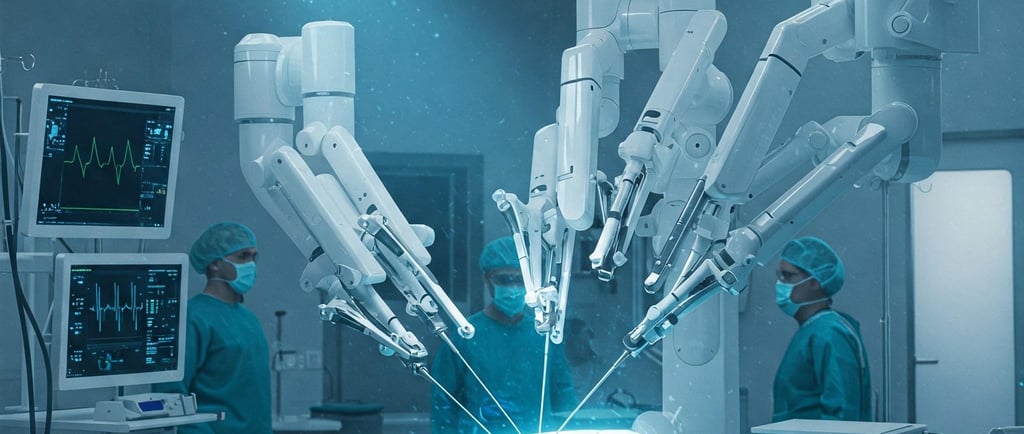Smart Anesthesia: How AI is Transforming Perioperative Monitoring
Artificial Intelligence (AI) is rapidly reshaping healthcare, notably in anesthesiology, by enhancing perioperative monitoring and patient safety. Smart anesthesia systems employing AI-driven technologies offer unprecedented precision, predictive capabilities, and automation, significantly transforming anesthetic practices. This article delves into the advancements, practical applications, and critical considerations anesthesiologists must evaluate in adopting AI solutions
MK Waikwa
4/6/20253 min read


AI Applications in Perioperative Monitoring
Real-Time Predictive Analytics
AI systems analyze continuous streams of patient data, including vital signs, anesthesia depth, and physiological parameters, predicting adverse events such as hypotension, hypoxia, or arrhythmias before clinical signs manifest.
Example: AI-driven platforms predicting intraoperative hypotension minutes before occurrence, allowing proactive management to prevent organ damage.
Closed-Loop Anesthesia Delivery
Automated anesthesia delivery systems adjust drug dosages in real-time based on patient responses and AI-predicted needs.
Example: Systems like closed-loop propofol infusion guided by bispectral index (BIS) monitoring for optimal sedation levels.
Personalized Anesthetic Management
Machine learning models integrate patient-specific data (medical history, genetic factors, prior responses to anesthesia) to tailor anesthetic plans, enhancing patient safety and satisfaction.
Addressing Concerns in AI Integration
While promising, AI integration raises several critical considerations:
Reliability and Validation
AI algorithms must be rigorously validated across diverse patient populations to avoid biases and inaccuracies.
Dependence on AI requires clinicians to maintain critical oversight to ensure system accuracy and appropriate intervention.
Ethical and Legal Implications
Defining accountability in AI-driven decisions—particularly when errors occur—necessitates clear guidelines and regulatory frameworks.
Ensuring transparency in algorithmic decision-making to maintain patient trust and professional integrity.
Data Privacy and Cybersecurity
The management of patient data within AI systems demands stringent cybersecurity measures to protect patient privacy and prevent breaches.
Making Informed Technology Choices
Anesthesiologists considering AI-driven technologies should assess several key factors:
Clinical Validation: Review robust clinical evidence supporting the efficacy and safety of specific AI technologies.
Integration Capabilities: Evaluate how seamlessly the technology integrates with existing hospital systems and workflows.
Training and Education: Consider the extent of training and support provided by the technology provider to ensure optimal use and understanding of the system.
Risk Mitigation: Assess potential risks, including algorithm failure scenarios, and the systems’ fallback protocols for maintaining patient safety.
Future Directions
The future of smart anesthesia includes further advancements in machine learning algorithms, predictive analytics for perioperative complications, and greater integration of AI systems into routine anesthetic care. Continuous innovation, combined with robust clinical validation and responsible integration, will unlock the full potential of AI in anesthesia.
Conclusion
Artificial intelligence represents a significant leap forward in anesthetic care, offering improved safety, precision, and patient outcomes. However, thoughtful and informed adoption, addressing validation, ethical considerations, and data security, is crucial. By carefully evaluating AI-driven technologies, anesthesiologists can harness their full potential to advance patient care in perioperative medicine.
AI Applications in Perioperative Monitoring
Real-Time Predictive Analytics
AI systems analyze continuous streams of patient data, including vital signs, anesthesia depth, and physiological parameters, predicting adverse events such as hypotension, hypoxia, or arrhythmias before clinical signs manifest.
Example: AI-driven platforms predicting intraoperative hypotension minutes before occurrence, allowing proactive management to prevent organ damage.
Closed-Loop Anesthesia Delivery
Automated anesthesia delivery systems adjust drug dosages in real-time based on patient responses and AI-predicted needs.
Example: Systems like closed-loop propofol infusion guided by bispectral index (BIS) monitoring for optimal sedation levels.
Personalized Anesthetic Management
Machine learning models integrate patient-specific data (medical history, genetic factors, prior responses to anesthesia) to tailor anesthetic plans, enhancing patient safety and satisfaction.
Addressing Concerns in AI Integration
While promising, AI integration raises several critical considerations:
Reliability and Validation
AI algorithms must be rigorously validated across diverse patient populations to avoid biases and inaccuracies.
Dependence on AI requires clinicians to maintain critical oversight to ensure system accuracy and appropriate intervention.
Ethical and Legal Implications
Defining accountability in AI-driven decisions—particularly when errors occur—necessitates clear guidelines and regulatory frameworks.
Ensuring transparency in algorithmic decision-making to maintain patient trust and professional integrity.
Data Privacy and Cybersecurity
The management of patient data within AI systems demands stringent cybersecurity measures to protect patient privacy and prevent breaches.
Making Informed Technology Choices
Anesthesiologists considering AI-driven technologies should assess several key factors:
Clinical Validation: Review robust clinical evidence supporting the efficacy and safety of specific AI technologies.
Integration Capabilities: Evaluate how seamlessly the technology integrates with existing hospital systems and workflows.
Training and Education: Consider the extent of training and support provided by the technology provider to ensure optimal use and understanding of the system.
Risk Mitigation: Assess potential risks, including algorithm failure scenarios, and the systems’ fallback protocols for maintaining patient safety.
Future Directions
The future of smart anesthesia includes further advancements in machine learning algorithms, predictive analytics for perioperative complications, and greater integration of AI systems into routine anesthetic care. Continuous innovation, combined with robust clinical validation and responsible integration, will unlock the full potential of AI in anesthesia.
Conclusion
Artificial intelligence represents a significant leap forward in anesthetic care, offering improved safety, precision, and patient outcomes. However, thoughtful and informed adoption, addressing validation, ethical considerations, and data security, is crucial. By carefully evaluating AI-driven technologies, anesthesiologists can harness their full potential to advance patient care in perioperative medicine.
